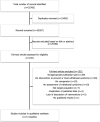Strategies for the Prevention and Treatment of Iatrogenic Withdrawal from Opioids and Benzodiazepines in Critically Ill Neonates, Children and Adults: A Systematic Review of Clinical Studies
- PMID: 32592134
- PMCID: PMC7317263
- DOI: 10.1007/s40265-020-01338-4
Strategies for the Prevention and Treatment of Iatrogenic Withdrawal from Opioids and Benzodiazepines in Critically Ill Neonates, Children and Adults: A Systematic Review of Clinical Studies
Abstract
Background: Critically ill patients are at high risk of iatrogenic withdrawal syndrome (IWS), due to exposure to high doses or prolonged periods of opioids and benzodiazepines.
Purpose: To examine pharmacological management strategies designed to prevent and/or treat IWS from opioids and/or benzodiazepines in critically ill neonates, children and adults.
Methods: We included non-randomised studies of interventions (NRSI) and randomised controlled trials (RCTs), reporting on interventions to prevent or manage IWS in critically ill neonatal, paediatric and adult patients. Database searching included: PubMed, CINAHL, Embase, Cochrane databases, TRIP, CMA Infobase and NICE evidence. Additional grey literature was examined. Study selection and data extraction were performed in duplicate. Data collected included: population, definition of opioid, benzodiazepine or mixed IWS, its assessment and management (drug or strategy, route of administration, dosage and titration), previous drug exposures and outcomes measures. Methodological quality assessment was performed by two independent reviewers using the Cochrane risk of bias tool for RCTs and the ROBINS-I tool for NRSI. A qualitative synthesis of the results is provided. For the subset of studies evaluating multifaceted protocolised care, we meta-analysed results for 4 outcomes and examined the quality of evidence using GRADE post hoc.
Results: Thirteen studies were eligible, including 10 NRSI and 3 RCTs; 11 of these included neonatal and paediatric patients exclusively. Eight studies evaluated multifaceted protocolised interventions, while 5 evaluated individual components of IWS management (e.g. clonidine or methadone at varying dosages, routes of administration and duration of tapering). IWS was measured using an appropriate tool in 6 studies. Ten studies reported upon occurrence of IWS, showing significant reductions (n = 4) or no differences (n = 6). Interventions failed to impact duration of mechanical ventilation, ICU length of stay, and adverse effects. Impact on opioid and/or benzodiazepine total doses and duration showed no differences in 4 studies, while 3 showed opioid and benzodiazepine cumulative doses were significantly reduced by 20-35% and 32-66%, and treatment durations by 1.5-11 and 19 days, respectively. Variable effects on intervention drug exposures were found. Weaning durations were reduced by 6-12 days (n = 4) for opioids and/or methadone and by 13 days (n = 1) for benzodiazepines. In contrast, two studies using interventions centred on transition to enteral routes or longer tapering durations found significant increases in intervention drug exposures. Interventions had overall non-significant effects on additional drug requirements (except for one study). Included studies were at high risk of bias, relating to selection, detection and reporting bias.
Conclusion: Interventions for IWS management fail to impact duration of mechanical ventilation or ICU length of stay, while effect on occurrence of IWS and drug exposures is inconsistent. Heterogeneity in the interventions used and methodological issues, including inappropriate and/or subjective identification of IWS and bias due to study design, limited the conclusions.
Conflict of interest statement
The authors (BS, MAD, MMP, DRW, AJF, PR, CG, LDB, SM, MD, AL, PD) have no conflict of interest to declare.
References
-
- Payen JF, Chanques G, Mantz J, Hercule C, Auriant I, Leguillou JL, et al. Current practices in sedation and analgesia for mechanically ventilated critically ill patients: a prospective multicenter patient-based study. Anesthesiology. 2007;106(4):687–695. doi: 10.1097/01.anes.0000264747.09017.da. - DOI - PubMed
-
- Burry LD, Williamson DR, Perreault MM, Rose L, Cook DJ, Ferguson ND, et al. Analgesic, sedative, antipsychotic, and neuromuscular blocker use in Canadian intensive care units: a prospective, multicentre, observational study. Can J Anaesth (Journal canadien d'anesthesie) 2014;61(7):619–630. doi: 10.1007/s12630-014-0174-1. - DOI - PubMed
Publication types
MeSH terms
Substances
LinkOut - more resources
Full Text Sources


